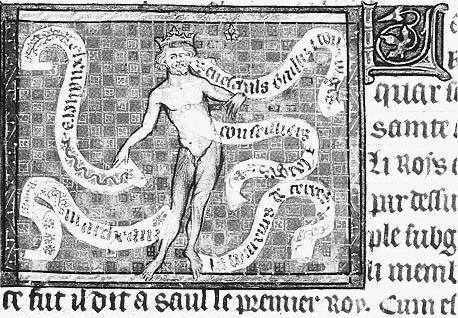The Analogy of the Body Politic
This aesthetic canon rests on a basic metaphor of Western political thought: the analogy of the body politic. First developed by Plato in the Republic and the Laws , it is restated by Aristotle at the beginning of the Politics : "The polis is prior in the order of nature to the family and the individual. The reason for this is that the whole is necessarily prior [in nature] to the part. If the whole body be destroyed, there will not be a foot or a hand."[16] Substantially expanded by John of Salisbury in the Policraticus to create specific equivalents among parts of the body and parts of the state, the analogy of the body politic figures in Oresme's glosses and commentaries on Chapter 9 of Book II, Chapter 4 of Book V, and Chapter 10 of Book VII of the Politiques .[17] Oresme also includes a reference to the analogy in the index of noteworthy subjects of the Politiques under the heading Moiens en richeces : "Item, encor appert par une bele consideration qui compare la policie et ses parties a un corps et a ses membres" (Item, it again appears [through] a beautiful metaphor that compares the form of government and its parts to a body and its members).[18]
A rare visualization of the body-politic metaphor occurs in the Morgan Avis au roys (Fig. 63). Adapted from the iconography of the zodiacal man, a nude, well-proportioned, crowned, and bearded male figure represents the physical embodiment of the political body. Inscriptions identify parts of the human body with functions and offices of certain social classes and institutions of government. The resulting hierarchy of political and social values corresponds to the traditional evaluations of the organs of the human body in ancient and medieval anatomical and philosophical texts. For example, occupying the representational and metaphorical top of the hierarchy of the body politic is the king who is its head. As the most distinctive part of the human anatomy, in which the soul, reason, intelligence, and sensations reside, the head is the ruling principle to which all other parts of the human body and the body politic are subject. Next, associated with the vital human faculties of vision and hearing, the seneschals, bailiffs, and provosts and other judges are compared to the eyes and ears of the body politic. The counsellors and wise men are linked to the essential function of the heart. As defenders of the commonwealth, the knights are identified with the hands. Because of their constant voyages around the world, the merchants are associated with the legs. Finally, laborers, who work close to the earth and support the body, are its feet.
Oresme's interpretation of the analogy emphasizes the economic context of undue concentration of power in a few hands as a threat to the welfare of the

Figure 63
The Body Politic. Avis au roys.
body politic. As noted earlier, Oresme had sounded this theme in his influential treatise of about 1356, De moneta .[19] Because of his reference to the Politics , Oresme's treatment of the analogy is worth citing:
The state or kingdom, then, is like a human body and so Aristotle will have it in Book V of the Politics . As, therefore, the body is disordered when the humours flow too freely into one member of it, so that member is often thus inflamed and overgrown while the others are withered and shrunken and the body's due proportions are destroyed and its life shortened; so also is a commonwealth or a kingdom when riches are unduly attracted by it.[20]
Interwoven with the body-politic analogy is Aristotle's concern with proportional relationships in aesthetics, ethics, and politics. Oresme's translations of the Ethics and the Politics reflect these important concepts. In addition, from a mathematical point of view, about 1350 he wrote a treatise on proportion, the De proportionibus proportionum .[21] A visual reference to Oresme's numerical use of proportional relationships occurs in the illustration of Justice distributive in Book V of A (Fig. 24). The program of the illustrations for Book IV of the Politiques will explore further the connections between political stability, the undue concentration of wealth in the hands of a few, and the analogy of the body politic.